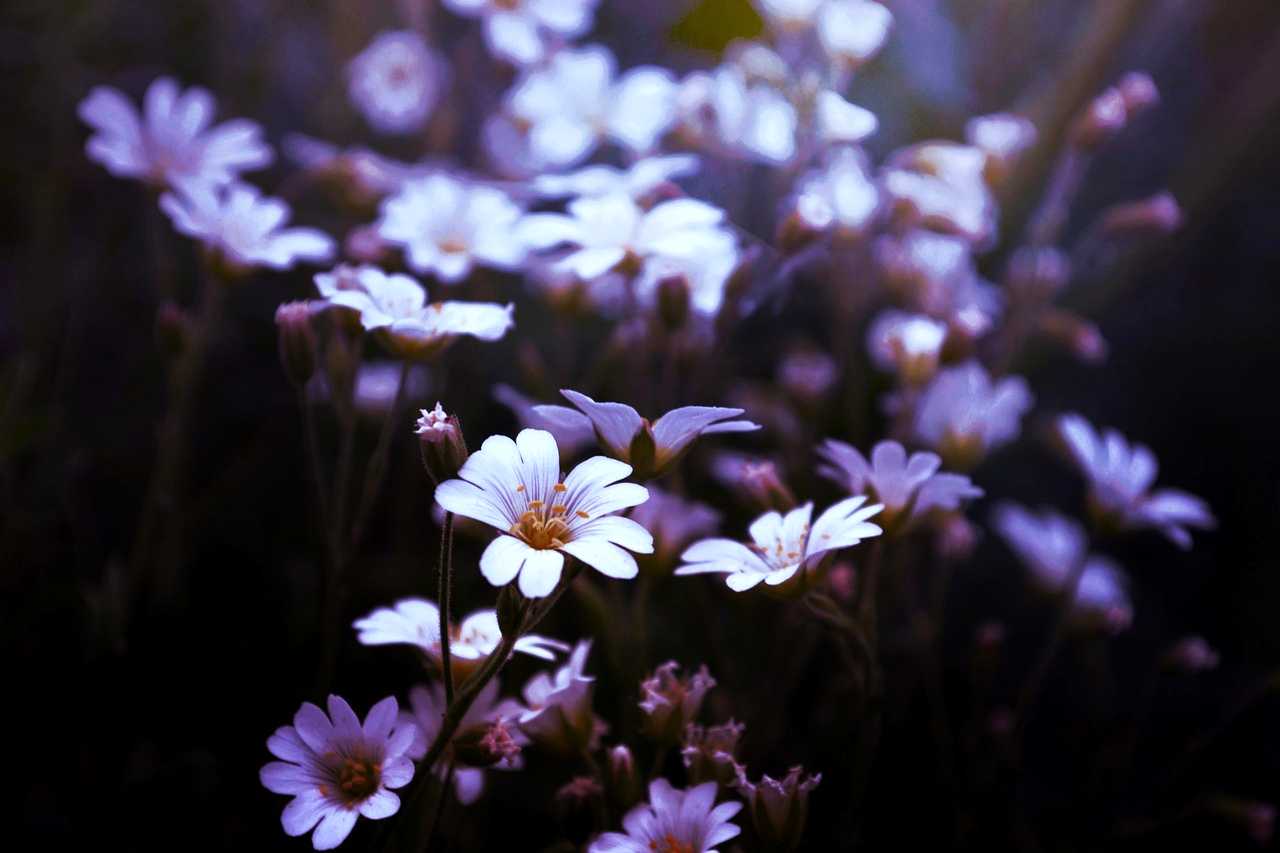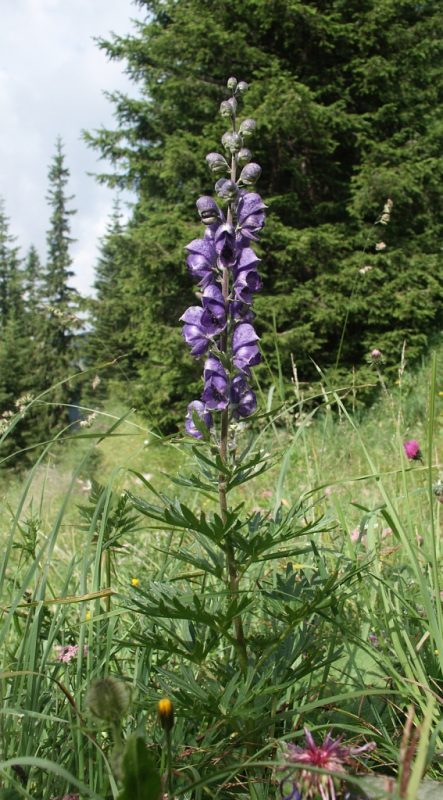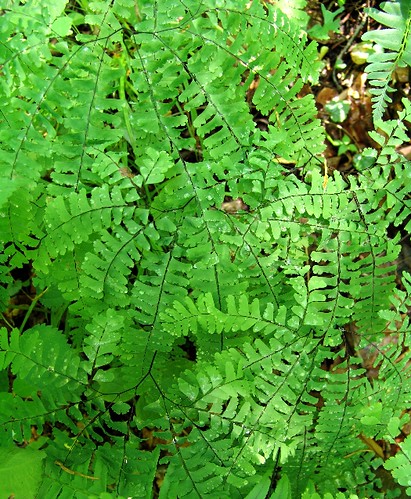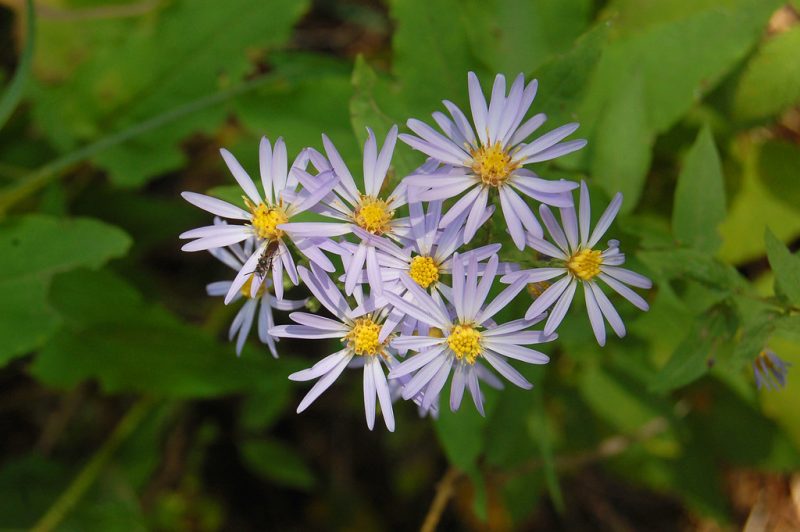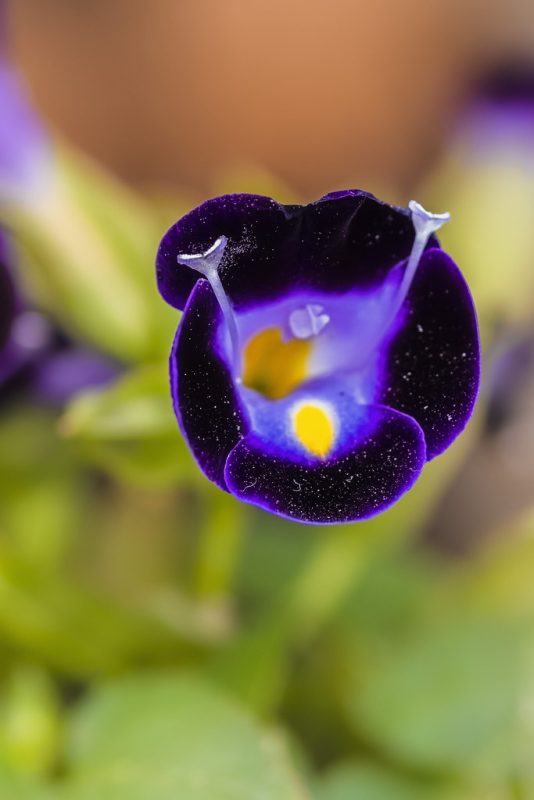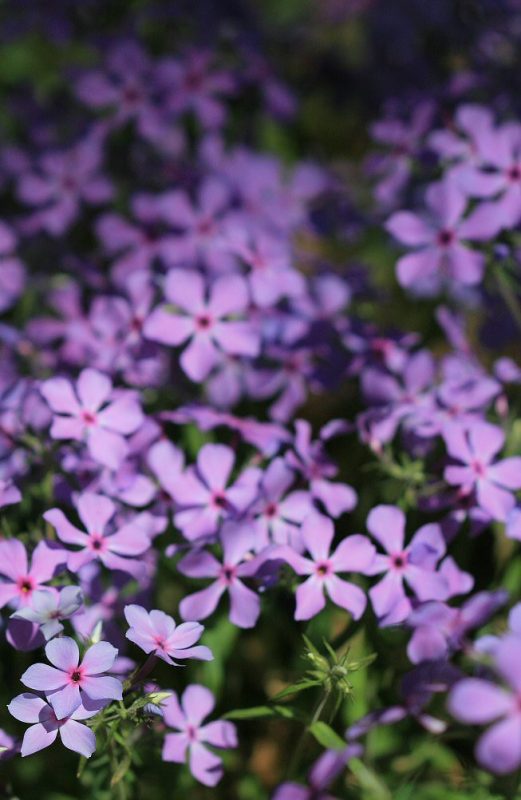As the leaves begin to turn and cooler temperatures set in, gardeners often seek to enrich their shaded areas with vibrant fall foliage and blooms. Whether you have deep shade cast by towering trees or dappled sunlight filtering through branches, choosing the right plants can transform your garden into a lush retreat.
Actaea

Commonly known as baneberry or cohosh, Actaea offers a stunning visual appeal during the fall months. This perennial is renowned for its striking foliage and unique flower spikes. The most popular species, Actaea racemosa, can grow up to 4 feet tall, providing an impressive vertical element to your shade garden.
One of the key features of Actaea is its dramatic mid to late summer bloom, which produces delicate white or cream-colored flowers that attract pollinators such as bees and butterflies. As the season progresses into fall, the foliage turns a rich purple or burgundy, adding depth and interest to shaded areas. The dark berries that follow are visually striking but should be admired from afar, as they are toxic if ingested.
Actaea thrives in moist, well-drained soils and prefers a location with partial to full shade. It works beautifully as a backdrop for other fall plants, allowing the warm hues of autumn to stand out even more. Incorporating Actaea into your garden offers both aesthetic pleasure and ecological benefits, fostering a diverse environment that supports various wildlife.
Aster
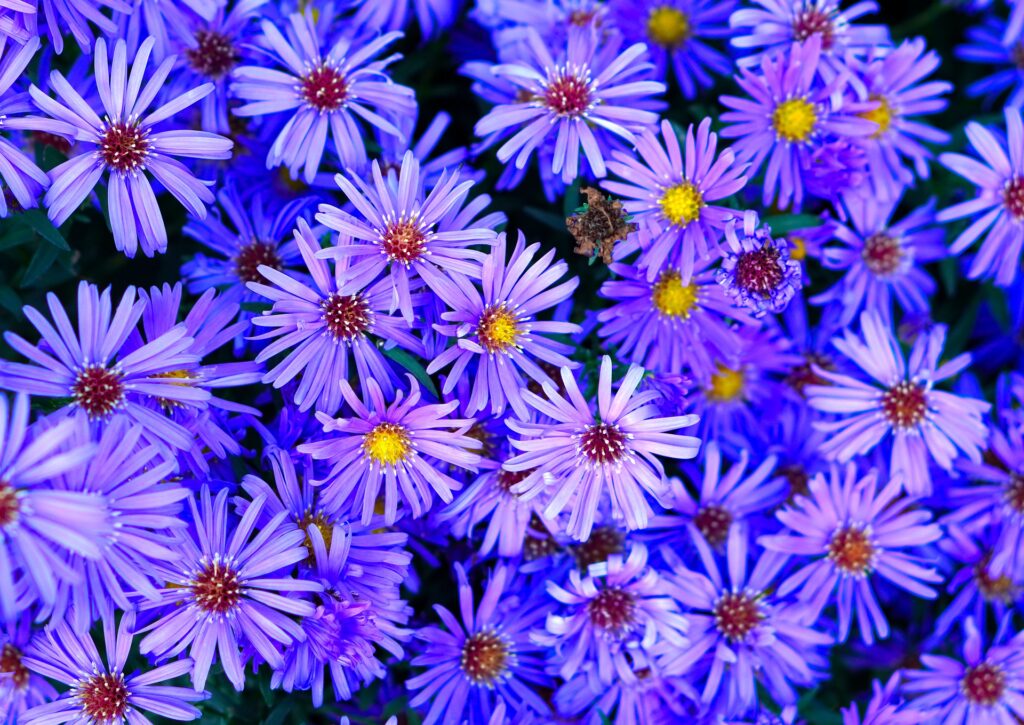
Few plants embody the spirit of autumn quite like Aster. As the growing season winds down, these resilient perennials burst into bloom with vibrant colors ranging from blues to purples, pinks, and whites. Aster species are perfect for shaded environments, making them a staple in fall gardens where sunlight may be limited.
One noteworthy cultivar is the New England Aster (Symphyotrichum novae-angliae), which can reach heights of up to 4 feet and showcases stunning clusters of daisy-like flowers. These blooms not only bring a pop of color to your landscape but also serve as a vital nectar source for pollinators preparing for the winter months. Asters typically bloom in late summer through fall, creating a beautiful transition in the garden as other plants begin to fade.
To cultivate Asters successfully, plant them in well-drained soil rich in organic matter. They thrive in partial shade but can tolerate full sun, making them incredibly versatile. Their spreading habit allows them to fill spaces effectively, creating a naturalistic look. Additionally, the foliage of Asters can also add texture to your garden; the deep green leaves provide a contrasting backdrop for their brilliant flowers, enhancing the overall visual appeal of shaded areas.
Astilbe
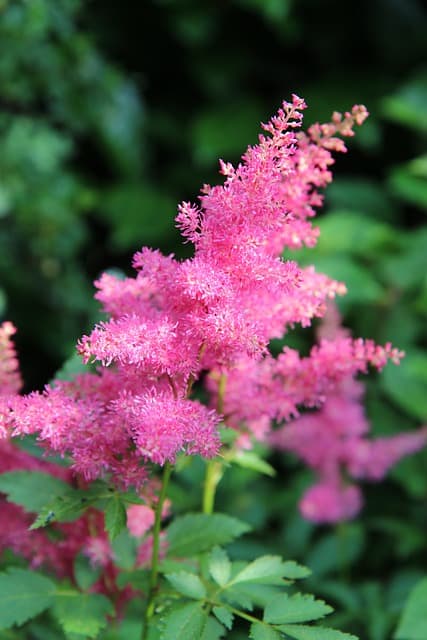
Astilbe is often celebrated for its feathery plumes and lush foliage, making it an ideal fall plant for shady gardens. This perennial is known for its airy spikes of flowers that bloom in various shades, including white, pink, and red, adding elegance and a touch of whimsy to any garden space. The flowers typically appear in mid to late summer and can persist into fall, particularly after a fall frost, when their vibrant colors often deepen.
One of the standout characteristics of Astilbe is its ability to thrive in consistently moist conditions, making it a perfect choice for areas that may collect rainfall or have nearby water features. This tenacity makes Astilbe valuable for gardeners looking to maximize the beauty of damp, shaded areas. The foliage of Astilbe adds a lush, fern-like quality to the garden, providing textural contrast against the more rigid shapes of other shade plants.
Astilbe also shines in mixed borders or as a ground cover, softening the edges of paved paths and garden walks. Best planted in well-drained, rich soil with a good amount of organic matter, these plants prefer partial to full shade. They are relatively low-maintenance and can be divided every few years to avoid overcrowding, allowing you to propagate new plants for other areas of your shade garden.
Autumn Crocus
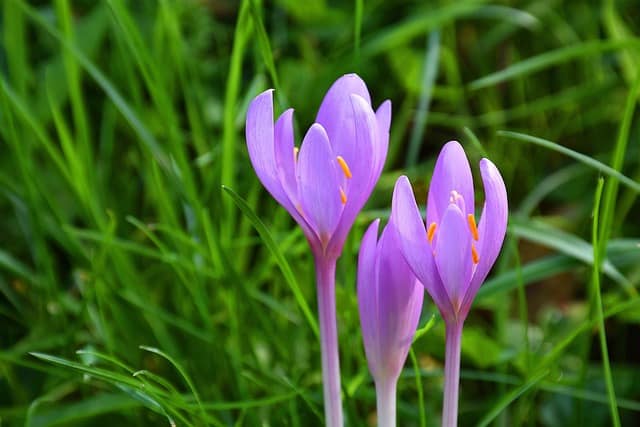
As the name suggests, Autumn Crocus (Colchicum autumnale) brings a burst of color to the fall landscape, making it a noteworthy addition to any shade garden. Emerging from the ground after summer’s end, these bulbous plants produce stunning, goblet-shaped flowers that grace the landscape when many others have started to fade. The blooms appear in September and October, providing a welcome surprise just as the leaves are changing.
What makes Autumn Crocus particularly engaging is its striking blooms, which can range from soft lavender to deep purple and even bright white. This plant’s ability to thrive in partial to full shade makes it suitable for various garden types, especially those nestled under trees. One compelling aspect of the Autumn Crocus is its ability to naturalize, multiplying over the years to create larger drifts of color.
In terms of care, Autumn Crocus prefers well-drained soil that is enriched with organic matter, and it is essential to plant the bulbs at least 4 inches deep. They are quite drought-tolerant once established, requiring minimal maintenance. For garden designers looking to make an impact in shaded areas, planting clusters of Autumn Crocus can create stunning, seasonal interest as their vibrant blooms rise above the surrounding foliage.
Azalea
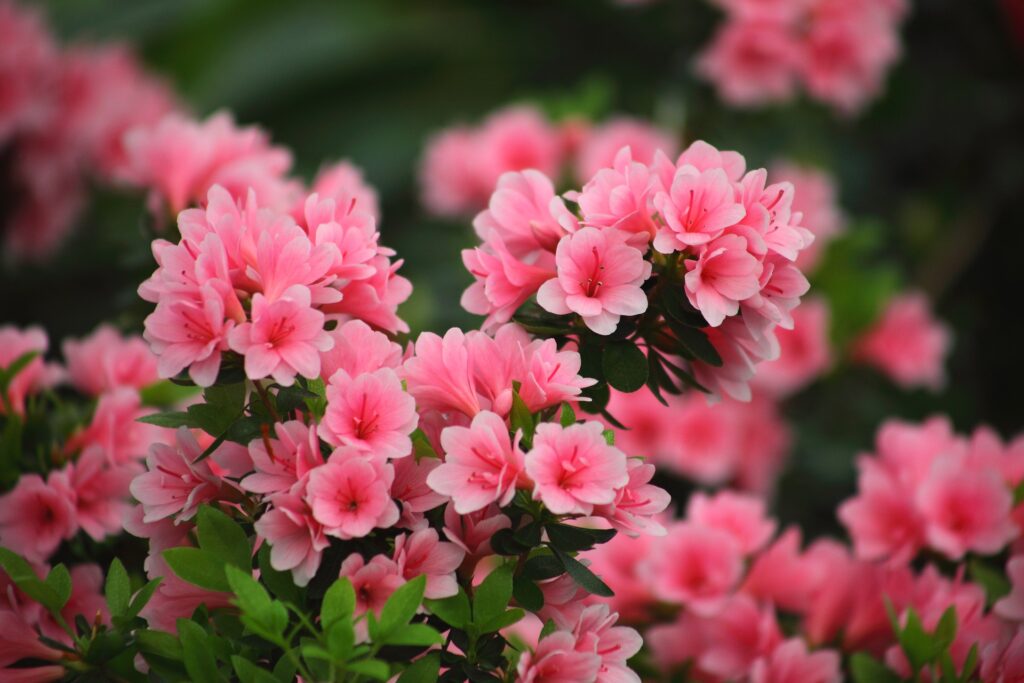
Azaleas are standout shrubs that can bring an exceptional splash of color to shaded areas during the fall. Known for their breathtaking flower displays in late spring, certain deciduous varieties also showcase their beauty later in the year. These plants feature trumpet-shaped blooms in an array of colors, from brilliant reds and pinks to soft pastels, giving your garden a festive feel.
One of the most appealing aspects of Azaleas is their ability to thrive in partially shaded to fully shaded environments. They prefer acidic, well-drained soils rich in organic matter, making them ideally suited for woodland gardens or areas that mimic their native habitats. As the foliage of Azaleas transitions into fall, it often takes on glowing shades of orange, red, and yellow, providing a stunning backdrop for the last blooms of the season.
When planning your garden, consider incorporating both evergreen and deciduous Azaleas to extend seasonal interest. The evergreen varieties retain their foliage and provide structure in winter gardens, while the deciduous types offer dynamic color displays during the cooler months. With a bit of pruning and care, Azaleas can flourish, bringing their gentle charm to shaded areas and drawing attention from passersby with their striking fall foliage and late-season blooms.
Beautyberry
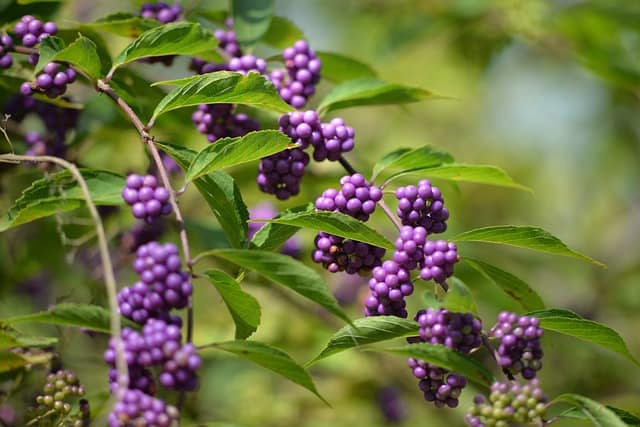
For gardeners seeking unique foliage and striking berries, Beautyberry (Callicarpa americana) is an outstanding choice for fall shade gardens. This deciduous shrub is easily recognizable thanks to its clusters of brilliant purple berries that develop along the stems in late summer and persist into fall, attracting birds and wildlife to the garden. The contrast of the vibrant berries against their dark green leaves creates a captivating visual spectacle as summer transitions into autumn.
Beyond their berries, Beautyberry plants provide excellent shrubbery cover with their arching branches and dense foliage. They thrive in partial to full shade and prefer well-drained soil, making them an adaptable option for less sunny spots in your garden. The fall season, in particular, is when the foliage can take on a stunning yellowish hue, adding additional warmth to your shaded spaces.
While Beautyberry is relatively low-maintenance, regular pruning can enhance the shrub’s shape and encourage denser growth. This helps to maximize the visibility of their exhilarating fruit, ensuring a vibrant display throughout the fall months. By incorporating Beautyberry into your garden, not only do you create visually appealing contrasts, but you also foster a habitat conducive to local bird populations.
Begonia
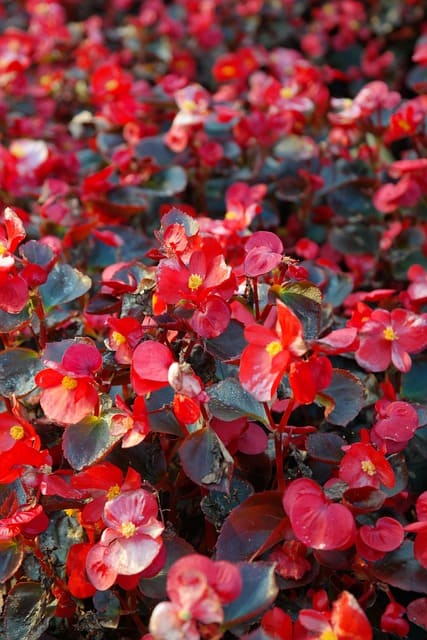
Begonias are among the most versatile and aesthetically pleasing plants, making them ideal for shaded areas in the fall garden. These perennials boast a wide variety of leaf shapes, sizes, and colors, with many hybrids showcasing eye-catching variegations and textures. While famous for their vibrant blooms in summer, certain Begonia species and hybrids maintain their visually arresting foliage well into the cooler months, creating a lovely backdrop of color when most other plants begin to fade.
Discovering Begonias like the Rex Begonia is especially exciting, as they thrive in partial shade and offer uniquely patterned leaves in shades of silver, red, and green. The foliage tends to take on a more dramatic and intense coloration as temperatures drop, enriching the garden’s visual appeal. Planting these in containers or directly in shaded garden beds allows the leaves to complement fall decorations and seasonal theme gardens beautifully.
Caring for Begonias is manageable: they prefer consistently moist but well-draining soil, and while they thrive in indirect sunlight, it is crucial to protect them from harsh, direct sun, which can scorch their leaves. With their bold presence and tactile allure, Begonias can provide a lush, tropical mood to fall gardens, making them a popular choice for gardeners looking to extend the season’s beauty.
Black-Eyed Susan
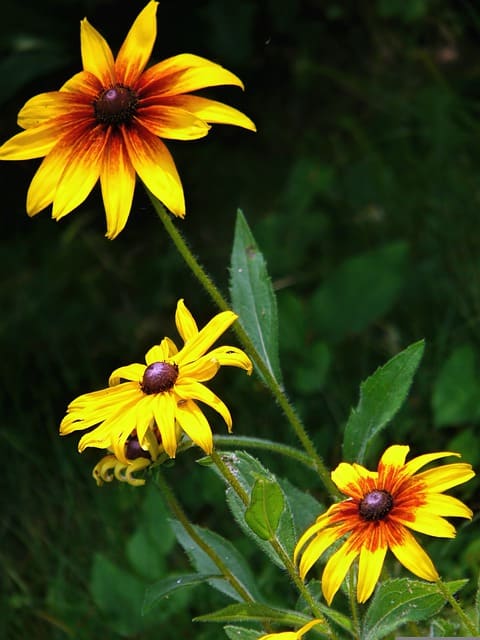
Black-Eyed Susans (Rudbeckia hirta) are iconic wildflowers that bring a cheerful splash of color to shaded areas during the transitional months of fall. Although they are often associated with sunny meadows and prairies, many varieties of Black-Eyed Susans can thrive in partial shade, allowing them to grace shadier gardens with their vibrant yellow and orange blooms. These hardy perennials can bloom from mid-summer through fall, extending their display well into the autumn season.
The bold, daisy-like flowers of Black-Eyed Susan feature a deep brown or black center, surrounded by bright, radiant petals that seem to dance in the breeze. This cheerful display not only adds a pop of color to the fall palette but also attracts beneficial pollinators such as bees and butterflies, providing essential forage as they prepare for winter.
To plant Black-Eyed Susans in shaded areas, ensure they receive at least a few hours of direct sunlight each day for optimal blooming. They thrive in well-drained, loamy soil and can tolerate a range of conditions, making them relatively easy to care for. Their resilience and ability to spread make them excellent ground-covering plants, filling in spaces while brightening shaded corners of your garden.
Bleeding Heart
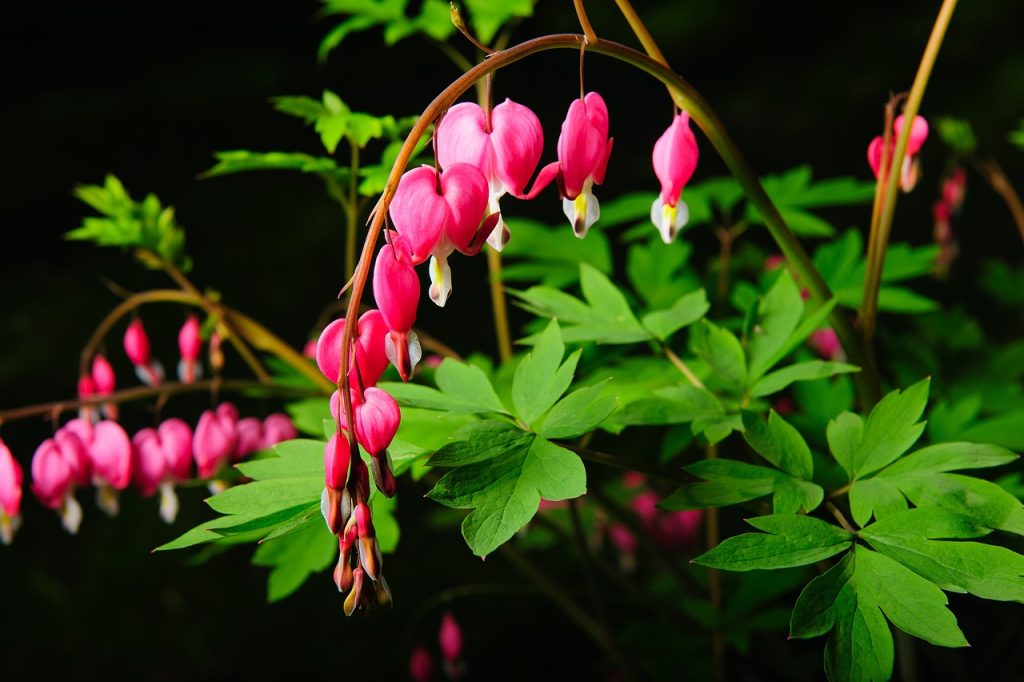
Bleeding Heart (Dicentra spectabilis) adds an enchanting charm to any fall shade garden, captivating onlookers with its whimsical, heart-shaped flowers. This perennial is known for its graceful, arching stems adorned with unique blossoms that dangle like delicate earrings. The flowers bloom in shades of pink and white, adding a soft touch to shaded areas as fall approaches.
While Bleeding Heart typically blooms in spring, the enchanting fern-like foliage persists well into the fall, providing lush greenery that complements the overall garden aesthetic. As the temperatures cool, the leaves may take on a lovely golden hue, further enhancing the depth of color and texture in your shady garden.
Bleeding Heart thrives in rich, consistently moist soil and prefers partial to full shade, making it a perfect fit for woodland gardens. These plants love to establish in compositions with other shade-loving varieties, creating a harmonious blend of colors and shapes. However, it’s important to note that they do benefit from some protection in extremely harsh conditions.
For gardeners aiming to maximize visual interest and support biodiversity in shaded areas, Bleeding Heart is a standout choice. Its enchanting flowers and elegant foliage will undoubtedly steal the spotlight, creating a serene atmosphere in any fall garden.
Blue Mistflower
Blue Mistflower (Conoclinium coelestinum), also known as aster or wild ageratum, is a fabulous choice for adding a cool burst of color to shaded gardens in the fall. With clusters of fluffy, lavender-blue flowers adorning its stalks, Blue Mistflower blooms from late summer into autumn, providing a stunning display that attracts an array of pollinators, including butterflies and bees, who seek out its nectar-rich blossoms.
This native perennial thrives in various soil types, including clay and moist, well-drained soils, making it highly adaptable and low-maintenance. It’s particularly well-suited for areas with light to moderate shade, where it can spread comfortably to create natural-looking colonies. A delightful feature of Blue Mistflower is that it can thrive in somewhat challenging conditions, including spot where other plants may struggle.
Besides its striking visual appeal, Blue Mistflower also plays a vital role in enhancing local ecosystems. Its late-season blooms serve as a food source for essential pollinators preparing for their winter migration. Consider interplanting Blue Mistflower with contrasting foliage plants, like ferns or hostas, to create an inviting, textured landscape that showcases the beauty of fall.
Bottle Gentian
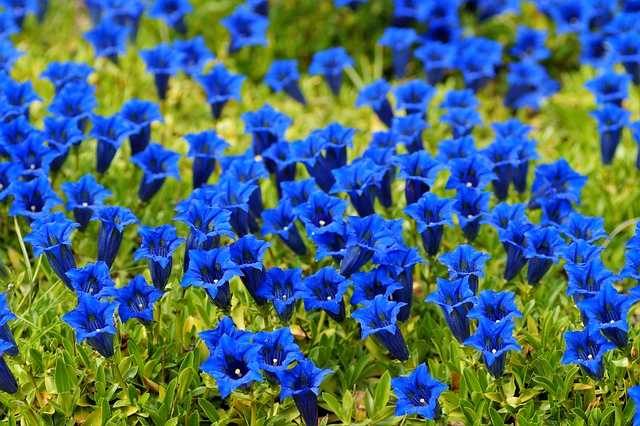
Bottle Gentian (Gentiana andrewsii) stands out as one of the most captivating plants for fall shade gardens. Distinguished by its unique, tubular blue flowers that bloom in late summer to fall, this perennial brings a touch of elegance and rarity to the garden. The vivid cobalt blue petals are actually closed, a distinctive trait that gives the plant its name and adds to its charm.
Bottle Gentian thrives in partial to full shade and prefers rich, moist, well-drained soil, making it perfect for woodland settings or shaded borders. While it requires a bit more care during dry spells, once established, it can be relatively resilient in favorable conditions. The plant also appreciates protection from direct sunlight, which ensures its vibrant blooms remain intact.
Beyond its aesthetic appeal, Bottle Gentian is a significant plant for local wildlife. Its closed flowers are specifically adapted to attract certain pollinators, primarily bees, that can access the nectar hidden within the flowers. Additionally, the plant typically spreads slowly, making it an excellent choice for those who prefer a more contained approach to garden design without overpowering neighbors or more delicate species.
Checkerberry
Checkerberry (Gaultheria procumbens), also known as wintergreen, is an evergreen ground cover that offers great interest and resilience in shaded areas throughout the fall months. This low-growing shrub features glossy, dark green leaves that not only create a lush carpet underfoot but also develop beautiful red berries that persist well into winter, ensuring year-round appeal in your shade garden.
One of the key features of Checkerberry is its ability to thrive in acidic, moist conditions, making it well-suited for woodland gardens or areas with dappled sunlight. As temperatures cool in the fall, its leathery leaves turn to rich shades of burgundy, enhancing its already striking foliage and creating a vibrant display against the backdrop of fallen leaves.
Checkerberry berries are both decorative and functional; they are edible and can be enjoyed fresh or used in pies, jams, and teas. Moreover, their bright red color adds delightful pops of contrast among other shade plants as winter approaches. Additionally, Checkerberry is a valuable plant for wildlife, as both birds and mammals are drawn to its berries, making it an asset for fostering biodiversity in your garden.
Coral Bells
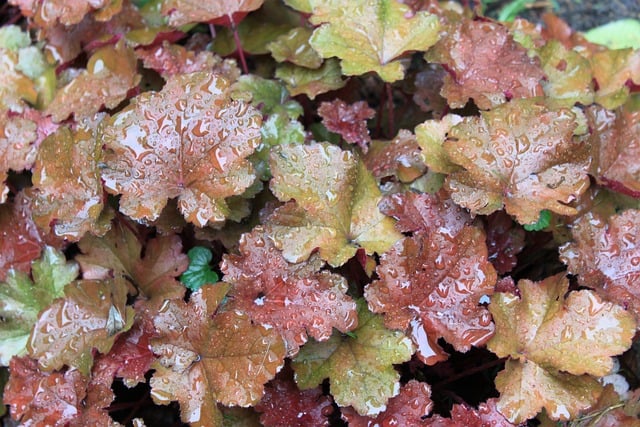
Coral Bells (Heuchera) are beloved for their stunning foliage and unique ability to thrive in shady conditions, making them an excellent addition to any fall garden. The diverse array of leaf colors, ranging from deep burgundy and bronze to bright lime green, allows gardeners to choose plants that complement their existing palette. The foliage of Coral Bells is often accompanied by delicate flower spikes that emerge in late spring or early summer, offering graceful blooms that continue to add interest into the fall.
As the season changes, the foliage of Coral Bells typically becomes even more pronounced, as the cooler temperatures enhance their colors and create a striking contrast with the more muted autumn landscape. This adaptability to shade makes Coral Bells an ideal choice for planting under trees or in partially shaded borders, where they can thrive without direct sunlight.
Additionally, Coral Bells are exceptionally resilient and require minimal maintenance. They prefer well-drained soil and can tolerate periods of drought once established. With their low-growing habit, they work beautifully as an understory plant that can add layers of beauty to your garden design. Pairing Coral Bells with other shade-loving perennials can create a lush, textural display that will remain captivating throughout the fall.
Croton
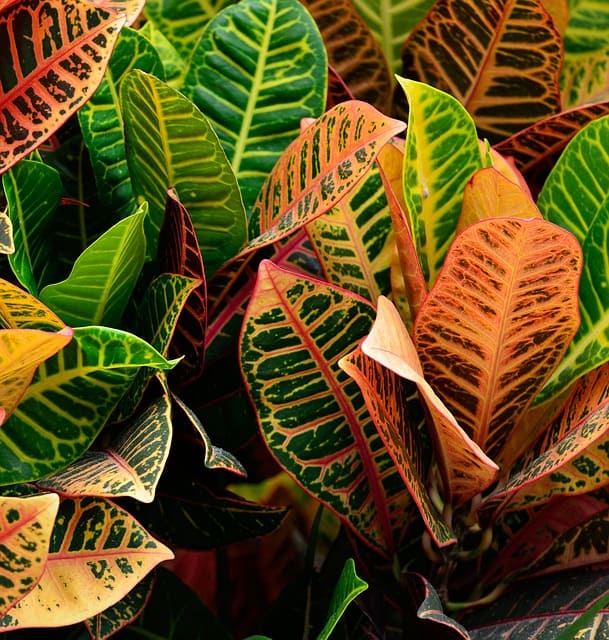
Croton (Codiaeum variegatum), known for its bold and colorful foliage, is a fantastic choice for adding dramatic flair to shaded gardens during the autumn months. Although Croton is typically associated with tropical climates, many varieties can adapt well to cooler conditions. Its leaves showcase an incredible palette of colors, including vibrant yellows, oranges, reds, and deep greens, making it a stunning focal point even in less sunny areas.
In the fall, as other plants may begin to dull, Croton’s foliage transforms, becoming more vivid and vibrant. The interplay of colors in its waxy leaves creates a captivating display that can easily draw attention to garden nooks and shaded corners. It’s important to note, however, that while Croton can tolerate some shade, it will thrive best with occasional direct sunlight, so consider placing it in bright, indirect light or spot locations that receive morning sun.
Caring for Croton involves ensuring that it receives humidity, as it thrives in moist environments. Regular watering and misting can help mimic these conditions, especially in the fall when indoor environments may dry out. Croton is often used in containers or as an accent plant among other perennials and shrubs, allowing for versatile garden arrangements that take full advantage of its eye-catching foliage.
Dianthus
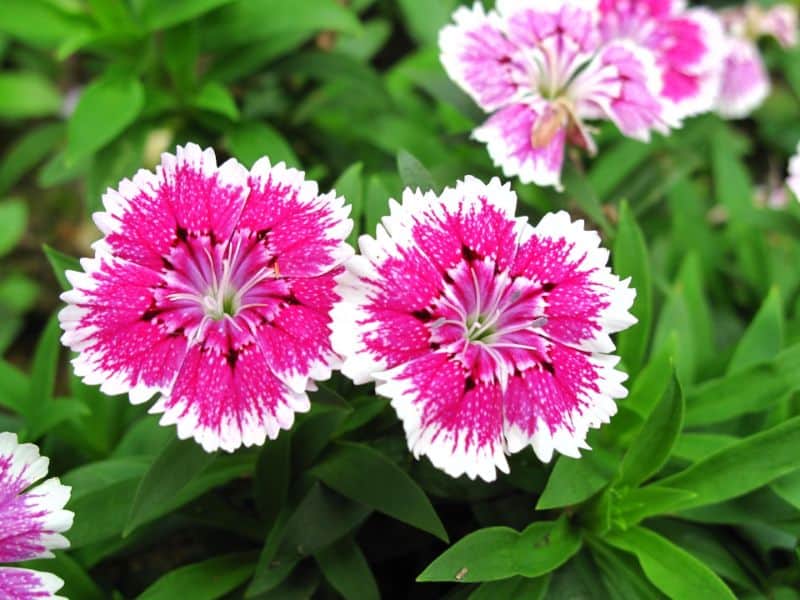
Dianthus, commonly known as “pinks,” are charming herbaceous perennials that add delightful color and fragrance to shaded areas in the fall. Renowned for their clove-scented blooms, which can range from soft pink to vibrant red, Dianthus plants offer a lovely contrast to some of the more muted tones of autumn foliage. Their flowers typically appear starting in late spring and can continue blooming well into early fall, providing an extended season of interest.
What sets Dianthus apart is its ability to thrive in partial shade, allowing gardeners with shaded gardens to enjoy their beauty. The foliage is usually narrow and grassy, giving it a delicate appearance that pairs well with bolder foliage plants. As the temperature cools, the blooms often become more vibrant, creating an enchanting display just as other plants begin to decline.
Dianthus is relatively easy to maintain, requiring well-drained soil and moderate watering. Its tolerance for drought makes it an excellent choice for areas with varying moisture levels. Consider grouping various Dianthus cultivars to create a visual tapestry that offers both continuous color and an inviting fragrance. Integrating these plants into your fall shade garden can create a harmonious blend of beauty and scent that draws in both people and pollinators alike.
Dogtooth Violet

Dogtooth Violet (Erythronium dens-canis) is a captivating wildflower that brings an enchanting touch to shaded gardens during the fall months. Characterized by its elegant, nodding flowers, which can vary in color from cream to pale yellow with purple markings, this plant becomes a star in woodland settings. Its unique name comes from the bulb’s tooth-like structure, reflecting both its charming appearance and its hardiness.
Dogtooth Violet blooms in early spring, but its lush, green foliage persists well into fall, providing a lovely backdrop as other flowers fade. The leaves are beautifully mottled with dark green and silver, creating a textural contrast against the fall’s more vibrant colors. This adaptability to shaded environments makes it an excellent choice for garden beds under tree canopies or in woodland gardens.
Dogtooth Violets thrive in well-draining, loamy soil and prefer partial to full shade, making them ideal for enriching the undergrowth. Once established, they can spread and form charming colonies, offering continual visual interest. Their presence invites beneficial insects and pollinators to your garden, promoting a healthy ecosystem within those shaded spaces.
Flowering Cabbage
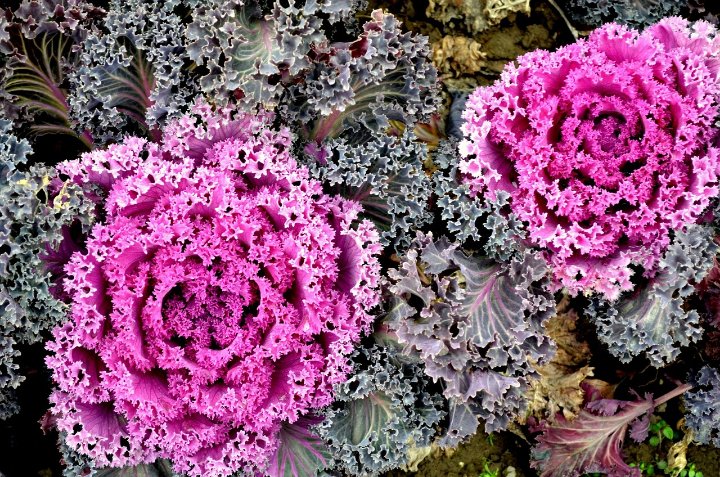
Flowering Cabbage (Brassica oleracea var. acephala), also known as ornamental kale, is a fantastic choice for adding vibrant colors and textures to shady areas during the fall and winter months. Renowned for its striking rosettes of green, purple, and white, Flowering Cabbage brings an instant pop of visual interest, especially as other plants begin to dwindle.
One of the remarkable features of Flowering Cabbage is its remarkable tolerance for cold temperatures; it can thrive even in frost, allowing for a longer display of color throughout the fall months. While it prefers full sun, it can comfortably adapt to partial shade, making it a flexible option for gardens where light may be limited.
As fall progresses, the vibrant colors of Flowering Cabbage intensify, resulting in an eye-catching contrast against the more muted tones of the autumn landscape. Planting these with other fall plants can create a lively display that captures the essence of the season. For gardeners looking to add structure and interest, consider using Flowering Cabbage as part of mixed containers or borders, allowing its textural appeal to shine among other foliage and flowers.
Foamflower
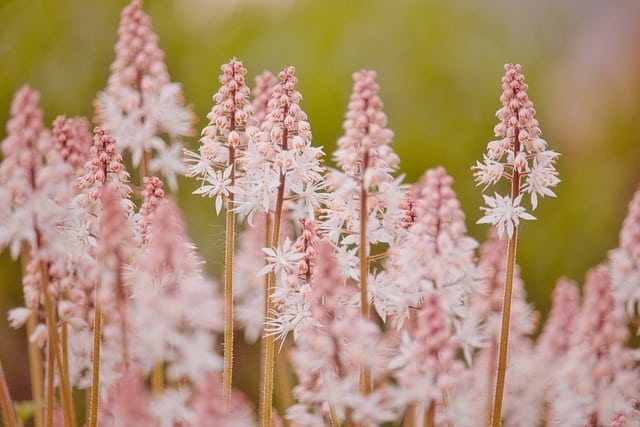
Foamflower (Tiarella cordifolia) is a delightful perennial that flourishes in shaded gardens, offering a combination of lush foliage and charming floral displays. Known for its intricate, lobed leaves resembling those of a maple, Foamflower adds a rich texture to any shady ground. The foliage creates a beautiful carpet that captures the eye, especially as it takes on deeper tones during the fall.
In late spring to early summer, Foamflower produces delicate spikes of tiny, fuzzy flowers that bloom in shades of white to pale pink. While the primary flowering season is earlier in the year, the foliage remains an attractive feature throughout the fall, providing interest amid the changing seasons. The leaves may develop lovely autumn hues, ranging from deep greens to subtle maroons, enhancing the depth of color in your shaded garden.
Foamflower is relatively low maintenance and thrives in moist, well-drained soils, making it an excellent choice for woodland gardens or areas where moisture levels are higher. As it prefers partial to full shade, it can flourish under trees or in dappled sunlight, offering an eco-friendly choice that supports local wildlife, including pollinators and beneficial insects.
Forget-Me-Not
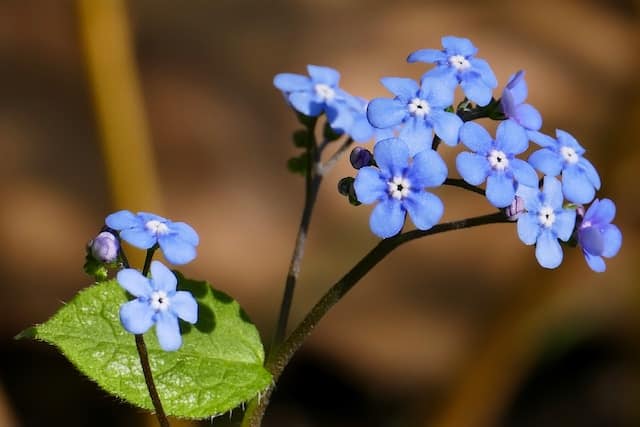
Forget-Me-Not (Myosotis sylvatica) is a charming perennial that brings a delightful splash of color to shaded areas as summer transitions into fall. Known for its petite, azure flowers, Forget-Me-Not serves as a charming reminder of spring’s fleeting beauty. Although it primarily blooms in spring, the plant’s lush green foliage remains vibrant throughout the fall, providing an essential foundation for your shaded garden.
This perennial thrives in well-drained, moist soil and prefers partial to full shade, making it an ideal candidate for woodland gardens or under the canopy of trees. The flowers, with their five-petal structure, are not just visually appealing; they also attract pollinators, including bees and butterflies, fostering biodiversity in your garden.
Forget-Me-Not’s adaptability and suitability for ground cover increase its value in shade gardening. After flowering, the plant produces small, seed-filled capsules that can self-seed, allowing it to create natural patches that persist from year to year. For a poetic touch, consider planting Forget-Me-Nots alongside other shade perennials to create a layered display that invokes a sense of nostalgia with its striking blue hues contrasting against the rich greens of neighboring plants.
Foxglove
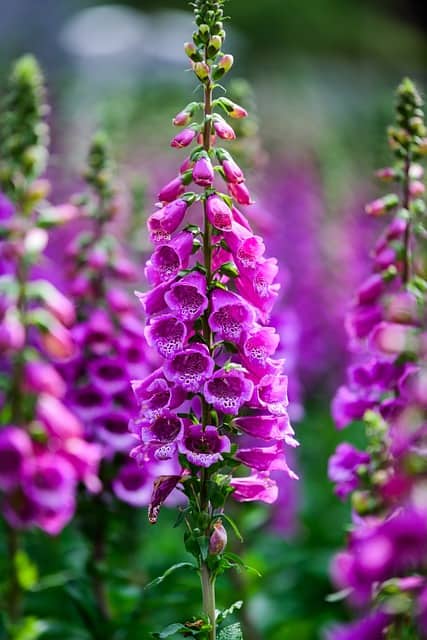
Foxglove (Digitalis purpurea) is a stunning biennial or short-lived perennial known for its tall, striking flower spikes, which can rise dramatically from the lower foliage, bringing vertical interest to shaded areas. The tubular flowers, available in shades of purple, pink, white, and yellow, produce a captivating display that can continue blooming in late summer through early fall, creating a colorful oasis even in low-light settings.
Thriving in partial shade, Foxglove prefers rich, well-drained soil and moist conditions, which makes it well-suited for gardens with occasional shade from larger plants or trees. Its towering floral spikes can act as a backdrop to lower-growing plants and create a lovely dynamism in your garden design. Not only does Foxglove brighten up shaded areas, but it also attracts hummingbirds and bees, adding movement and life to your garden.
While planting Foxglove, it’s essential to consider its biennial nature, which means the plants typically spend their first year developing foliage before flowering in their second year. To ensure a continuous bloom, stagger the planting of Foxglove seedlings so that you always have some in bloom while others are establishing. This technique enhances the overall aesthetics of your fall garden and maintains an ongoing supply of nectar for visiting pollinators.
Fuchsia

Fuchsia (Fuchsia spp.) is a beloved perennial that thrives in shady conditions, known for its dazzling, pendulous flowers that seem to dance in the breeze. The blooms typically exhibit a brilliant array of colors, ranging from deep fuchsia pinks to soft purples and whites, making them an eye-catching feature in any garden space. Fuchsia plants can flourish in pots or directly in the ground, allowing for versatile arrangements in shaded areas.
While Fuchsia usually blooms from mid-summer to early fall, its ability to thrive in cooler temperatures makes it an excellent choice for adding lasting color to your garden as the season winds down. The heart-shaped leaves provide a lush, rich backdrop to the colorful flowers, enhancing the overall visual impact of the plant in a shaded landscape.
To cultivate Fuchsia successfully, ensure it receives well-draining soil and adequate watering, particularly in dry spells. While Fuchsia can tolerate full shade, it also appreciates some filtered sunlight, which helps maintain vigorous blooming. Planting Fuchsia alongside other textural foliage and contrasting bloomers can create an engaging composition that transforms shaded areas into vibrant garden displays.
Goldenrod (Zigzag)

Zigzag Goldenrod (Solidago flexicaulis) stands out as a versatile perennial that thrives in shaded environments, bringing bursts of golden yellow blooms to fall gardens. Unlike many of its relatives that prefer full sun, Zigzag Goldenrod is perfectly adapted for partial shade, enriching understory plantings and adding character to woodland settings. Its unique zigzagging stems contribute to its common name, providing a visual rhythm that dynamically draws the eye through the garden.
In the fall, this plant’s golden flower clusters emerge, typically blooming from late summer through early autumn. These vibrant blooms not only add a cheerful splash of color but also serve as an essential nectar source for late-season pollinators, such as bees and butterflies. This makes Zigzag Goldenrod not just a beautiful addition but also a beneficial one, promoting biodiversity in your shaded garden.
Furthermore, the deep green foliage transforms with the arrival of fall, often taking on rich tones that complement the bright blooms. The plant prefers moist, well-drained soils and can be a wonderful choice for naturalizing, where it can spread gracefully and populate larger areas. Combining Zigzag Goldenrod with other shade-tolerant perennials allows for a stunning tapestry of color and texture that can light up even the shadiest corners of your garden.
Hellebore
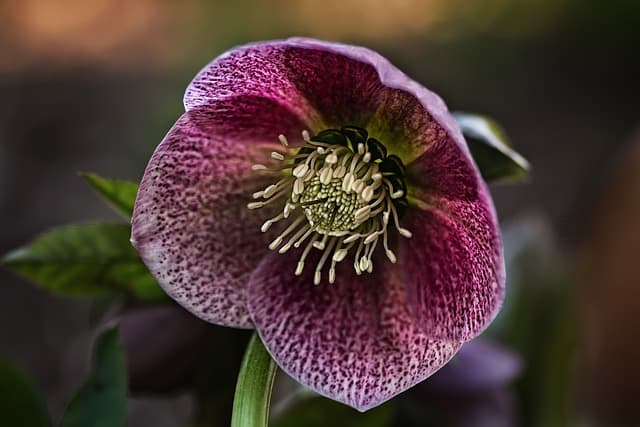
Hellebore (Helleborus spp.), sometimes known as the Christmas rose or Lenten rose, is a perennial that graces shaded areas with its elegant, cup-shaped flowers and glossy evergreen leaves. Blooming as early as late winter and continuing into spring, Hellebore plants can often surprise you with their enduring foliage and subtle charm in the fall. Though the primary flowering season is before fall, their continuous presence through the cooler months ensures they provide visual interest year-round.
These resilient plants thrive in a range of shade conditions, from partial to full shade, and can tolerate a variety of soil types as long as they are well-drained. In the fall, Hellebore’s lush foliage remains vibrant while the subtle shades of its flowers become more prominent as they peak through the foliage. The leaves take on a rich, deep green hue that contrasts beautifully with the fading colors of other plants, providing a grounding element in your shaded garden.
Hellebores are also known for their ability to withstand colder temperatures, making them an excellent choice for fall gardens in regions with chilly climates. Their adaptability makes them a lovely addition to mixed perennial borders, where they can be paired with ferns, heucheras, and other shade lovers to create a lush, layered effect. Additionally, Hellebore’s ability to attract pollinators adds to its appeal, allowing for a flourishing garden ecosystem even in the cooler months.
Hosta
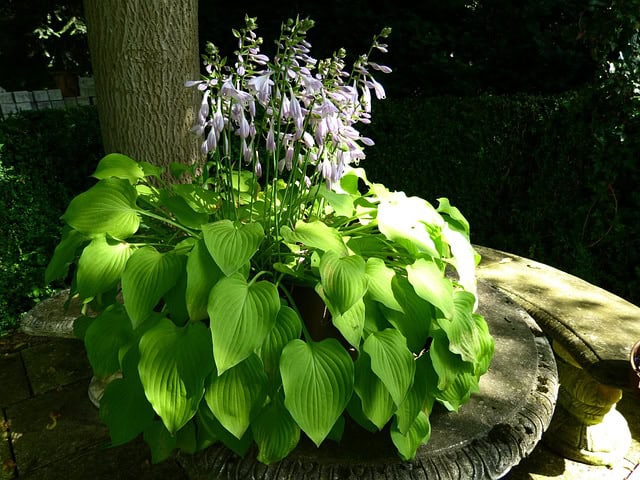
Hostas are a quintessential choice for shaded gardens, renowned for their stunning foliage and wide array of shapes, colors, and sizes. This versatile perennial thrives in low to moderate light, making it an ideal selection for shaded spaces. Hosta leaves can range from bright greens to deep blues and variegated patterns, creating an eye-catching display that transitions beautifully with the seasons.
In the fall, the foliage of Hosta takes on rich hues, adding depth and contrast to your garden. The towering flower spikes that emerge in summer often lend an additional layer of interest, with delicate blooms typically in whites, purples, or light blues. While the primary focus of Hosta is its ornate leaves, these flowers attract pollinators and contribute to a lively garden atmosphere.
Hostas thrive in well-drained, moist soils, and their extensive root systems help them establish themselves in shaded areas, making them excellent for underplanting trees or as border plants along paths. These hardy perennials can also be divided every few years, allowing gardeners to create more lush displays throughout their landscape.
To maximize the beauty of Hosta in your fall garden, consider pairing them with other foliage plants such as ferns or the previously mentioned Coral Bells, creating a layered effect that highlights the varying textures and colors. This thoughtful combination can result in a dynamic and attractive display that celebrates the beauty of shade-loving plants as the season shifts.
Hydrangea
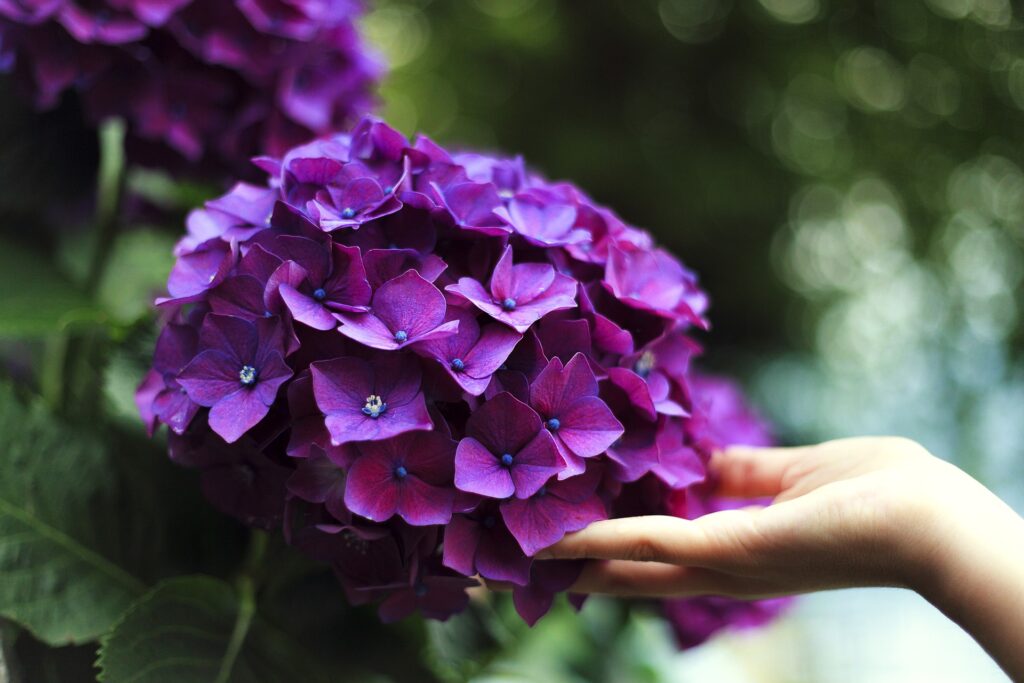
Hydrangeas are a classic choice for shaded gardens, offering a stunning range of colors and textures that can brighten even the dimmest corners. Among the different types, the smooth Hydrangea (Hydrangea arborescens) and the panicle Hydrangea (Hydrangea paniculata) are particularly well-suited for partial shade, making them versatile options for gardeners.
In the fall, many varieties of Hydrangea exhibit a beautiful transformation in color. The large flower clusters, often in shades of blue, pink, or white, can take on deeper blush tones, offering a rich visual experience as the foliage shifts toward autumn hues. Additionally, the aging flower heads turn intriguing shades of brown or beige, adding another layer of interest throughout the fall and winter months, providing year-round beauty even after the blooms have faded.
Hydrangeas thrive in well-drained soils that retain some moisture, which complements their preference for shaded or partially shaded environments. Regular hydration is key, particularly through the warmer months, but this adaptability allows many varieties to withstand varying conditions. Furthermore, incorporating Hydrangeas into your garden design can encourage interactions with pollinators, as their flowers attract bees and butterflies, promoting a lively ecosystem.
To enhance the beauty of your fall garden, consider planting Hydrangeas alongside shade-loving perennials or shrubs that bloom in complementary colors, creating a cohesive and visually striking landscape. Mixing different varieties of Hydrangeas can also result in breathtaking displays of texture and form, allowing you to enjoy a beautifully layered garden scene.
Impatiens
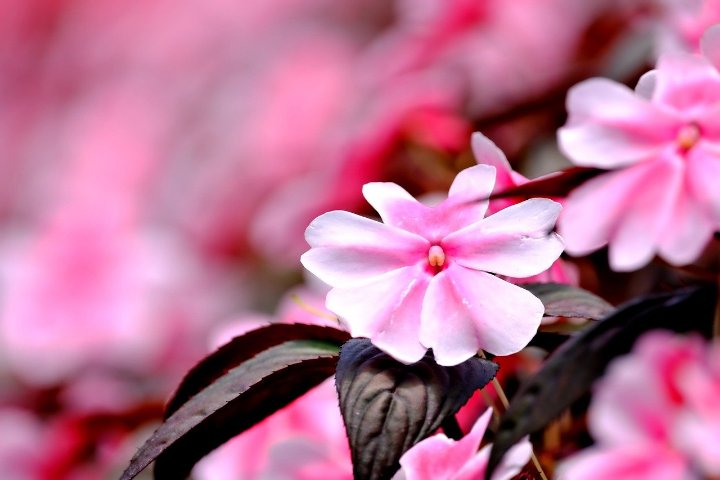
Impatiens are a favorite choice for gardeners seeking vibrant color in shaded spaces. Known for their lush blooms that come in a myriad of colors, ranging from brilliant reds and pinks to soft pastels, Impatiens thrive in areas with little to no direct sunlight. They are particularly valued for their ability to bring life and vibrancy to shaded flower beds, creating a cheerful and welcoming atmosphere as autumn approaches.
These annual plants flourish in moist, well-drained soils, making them perfect for borders or containers in shaded areas such as under trees or along shaded pathways. While Impatiens primarily flower during the summer months, their ability to bloom prolifically means that many varieties continue to provide color well into the fall, even after the temperatures begin to cool.
For gardeners looking to add a burst of color as other plants start to fade, Impatiens serve as an ideal complement to more subdued foliage plants. Mixing varieties with different bloom colors can create a dynamic visual display that keeps your garden looking fresh and lively throughout the changing season. Additionally, their compact growth habit makes them suitable for container arrangements, allowing you to reposition them as needed to maximize their impact in shaded nooks.
A unique aspect of Impatiens is their versatility in garden design; they pair beautifully with other fall plants for shade, creating harmonious combinations that enhance the overall aesthetic of your outdoor space.
Japanese Anemones
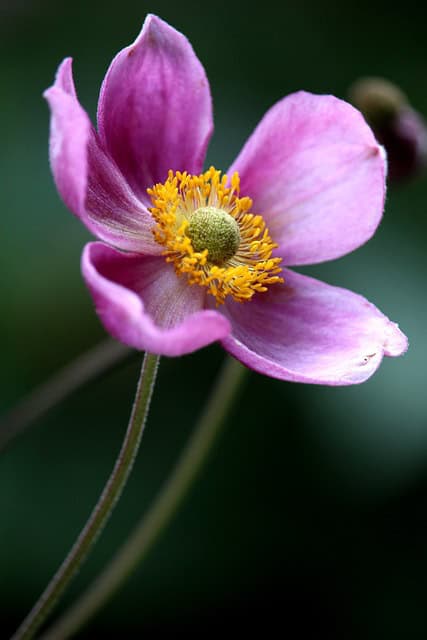
Japanese Anemones (Anemone hupehensis) are exquisite perennials that add elegance and grace to shaded gardens during the fall months. Renowned for their delicate, cup-shaped flowers in shades of white, pink, or lavender, these plants begin to bloom in late summer and continue to dazzle well into fall. Their airy flower stems bring a lightness to the garden, making them stand out amidst the more robust foliage of many other plants.
Preferred in partial shade, Japanese Anemones thrive in loamy, well-drained soils, making them suitable for a variety of garden conditions. These perennials create a graceful presence in low-light spaces, often naturalizing over time to form lovely colonies that gently sway in the breeze. Their low maintenance requirements and ability to re-bloom year after year make them a favored choice for gardeners looking to maintain color without extensive care.
As the blooms emerge in the fall, the dark green foliage can contrast beautifully with the vibrant flowers, creating an appealing visual harmony. They also attract pollinators, such as bees and butterflies, enhancing the ecological health of your garden. A mature planting of Japanese Anemones can be a spectacular sight, as their flowers rise above the foliage, invoking a sense of serenity and beauty in shaded areas.
Combining Japanese Anemones with other shade-loving plants, such as ferns or hostas, can provide a stunning tapestry of colors and textures that showcase the unique qualities of autumn. The layered design not only serves to visual diversity but also invites a myriad of wildlife into your garden, ensuring a thriving and resilient ecosystem.
Japanese Toad Lily (Miyazaki)
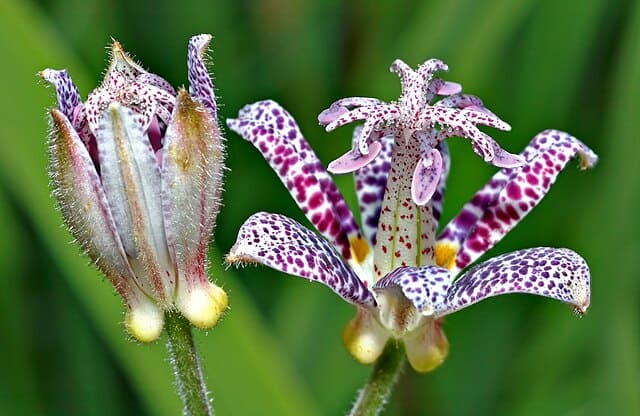
Japanese Toad Lily (Tricyrtis hirta ‘Miyazaki’) is a unique and elegant perennial that brings an exotic touch to shaded gardens in the fall. Renowned for its unique, speckled flowers, which resemble miniature orchids, this plant produces blooms in shades of lavender, white, and deep purple with intricate markings. The toad lily’s blooms typically appear in late summer and can persist into the fall, creating a captivating focal point as other plants begin to fade.
This perennial thrives in shaded environments and prefers rich, consistently moist soil, making it suitable for woodland gardens or shaded borders. Its elegant, arching stems and lush green foliage create a graceful backdrop for the stunning flowers. The plant is particularly valued for its ability to fill in spots in the garden that other perennials may not thrive in, adding texture and color throughout the fall.
Another appealing aspect of Japanese Toad Lily is its ability to attract pollinators, particularly bees and butterflies, contributing to the ecological health of your garden. Planting them near pathways or in areas where they can be easily appreciated will allow you and your guests to enjoy their unique beauty and intricate floral designs.
To create a magical fall display, consider incorporating Japanese Toad Lilies alongside ferns or other shade-loving foliage plants. This interesting combination enhances the variation and depth of your garden while showcasing the captivating blooms that make the toad lily a standout choice for shaded spaces.
Korean Angelica
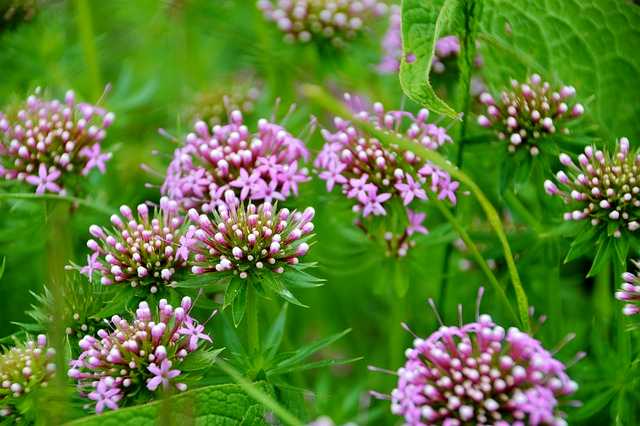
Korean Angelica (Angelica gigas) is a stunning and robust perennial known for its dramatic foliage and architectural form. With large, dark green, umbrella-shaped leaves, this plant makes a striking statement in shaded areas. Korean Angelica is particularly valued not only for its lush leaves but also for its eye-catching clusters of purple flowers that emerge in late summer and continue into fall, providing color when many other plants begin to dwindle.
This perennial thrives in moist, well-draining soil and prefers locations with partial shade to full shade, ideal for woodland or shaded garden beds. The striking leaves of Korean Angelica can help to create a lush environment, serving as an excellent backdrop for other fall-blooming plants. Additionally, its unique flower heads attract bees and butterflies, drawing pollinators into your garden during the crucial fall blooming period.
Korean Angelica can reach impressive heights, making it a perfect choice for creating vertical interest in your shaded garden. This, coupled with its attention-grabbing blooms, allows for extraordinary visual impact. To maximize its beauty, consider pairing it with lower-growing shade perennials, such as hostas or ferns, which will help to highlight its grandeur while providing a textured landscape.
Furthermore, the foliage of Korean Angelica may also develop deeper hues as the fall progresses, accentuating the plant’s striking appearance. Its strong presence amidst a collection of diverse shade plants creates an inviting and captivating environment that celebrates the beauty of the season.
Lamb’s Ear
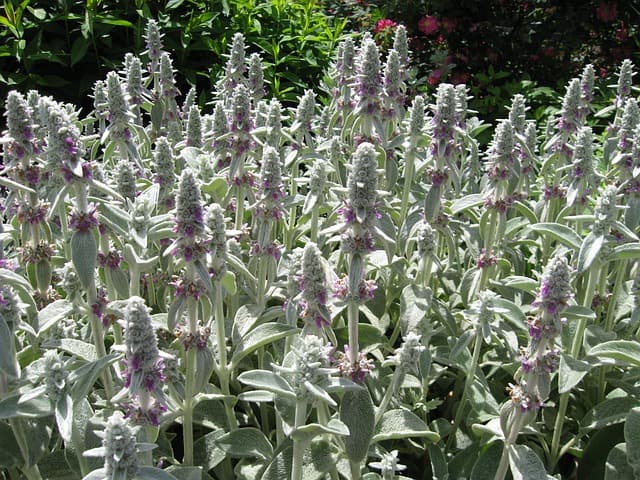
Lamb’s Ear (Stachys byzantina) is a delightful perennial that captivates gardeners not only with its unique, velvety foliage but also its adaptability to shaded environments. The leaves, which are soft to the touch and have a distinctive silver-gray hue, bring a soothing texture and color contrast to fall gardens. These tactile leaves serve as a stunning backdrop for any flower display, providing an appealing sense of depth while remaining low-maintenance.
In late summer and early fall, Lamb’s Ear produces tall spikes adorned with small, tubular purple flowers. Although these blooms are subtle, they attract pollinators such as bees and butterflies, contributing to the vibrant ecosystem of your shaded area. Furthermore, the structure of Lamb’s Ear allows it to thrive in a variety of conditions, making it suitable for both woodland gardens and more cultivated settings.
Lamb’s Ear prefers well-drained soil and can tolerate some drought, allowing for flexibility in planting. When paired with other shade-loving plants, such as ferns or hostas, it provides a luxurious contrast between its velvety leaves and their textures. Additionally, this plant works beautifully in mass plantings, creating an elegant sea of silver that catches the light beautifully, even in shaded areas.
Lily of the Valley
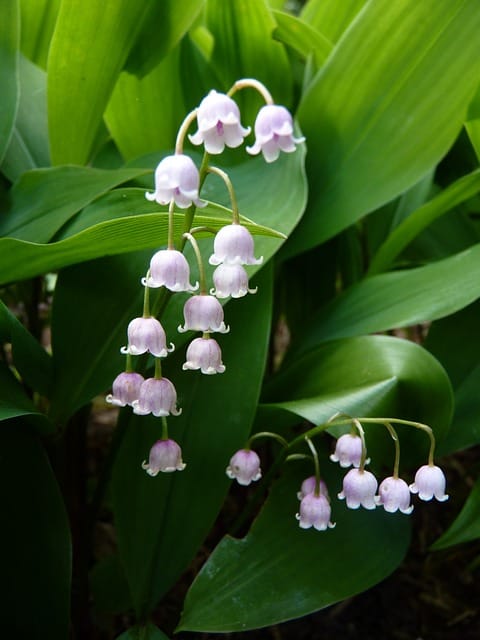
Lily of the Valley (Convallaria majalis) is a classic perennial known for its delicate, bell-shaped flowers and sweet fragrance. This charming plant thrives in shady conditions, making it a popular choice for woodland gardens and shaded borders. With its lush green leaves and month-long bloom period that extends into late spring, Lily of the Valley can create a vibrant carpet of foliage that lasts long after the flowers have faded.
In the fall, the lush foliage of Lily of the Valley provides a clean and rich backdrop. While the flowers are typically associated with early spring, the plant’s leaves can turn a beautiful golden hue as autumn approaches, adding warmth to the garden. Its compact growth habit allows it to naturalize easily, forming colonies that can fill out shaded spaces beautifully.
Lily of the Valley prefers well-drained, moist soils and can thrive in a variety of light conditions, although it flourishes best in partial to full shade. Not only is it a visually appealing addition to the garden, but it is also an ideal plant for attracting pollinators, benefiting the overall biodiversity in your shaded retreat. When planted in combination with plants that showcase flowers in late summer and early fall, Lily of the Valley can help you transition your garden’s appeal throughout the changing seasons.
Lobelia
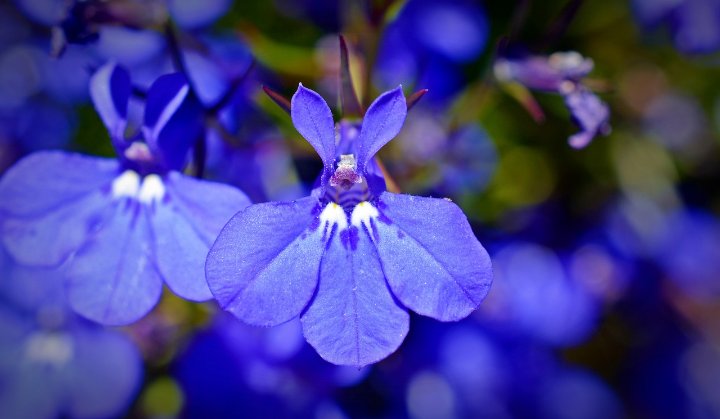
Lobelia is a versatile genus of plants known for its vibrant blue and purple flowers, which burst into bloom in the late summer and fall. Different species, such as Lobelia cardinalis (Cardinal Flower) and Lobelia erinus (Trailing Lobelia), offer variety, allowing gardeners to choose from both upright and trailing forms. These flowers provide a stunning contrast in shaded areas, brightening up any corner that may be lacking in color.
Lobelia prefers moist, well-drained soils and can tolerate partial shade, making them suitable accompaniments to other shade-loving plants. They thrive best in areas with consistent moisture, which can be more easily managed in shaded gardens where the sun’s intensity is reduced. In fall gardens, Lobelia’s blue and purple flowers can create dazzling displays that harmonize with the warm colors of autumn foliage, drawing attention even in low-light conditions.
Their elongated flower spikes attract various pollinators, such as butterflies and hummingbirds, making them not just beautiful but also beneficial for the ecosystem within your garden. Placing Lobelia among shrubs or along the edges of paths can create striking focal points that enhance the garden’s charm.
Incorporating Lobelia with other plants that bloom later in the season, like Japanese Toad Lily or Heartleaf Bergenia, can create stunning combinations of color and form, ensuring that your shaded garden retains its visual interest as autumn unfolds.
Lungwort
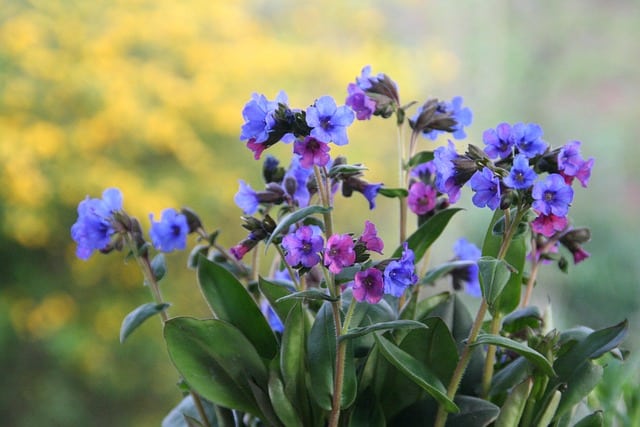
Lungwort (Pulmonaria) is a remarkable perennial that is cherished for its attractive foliage and early spring flowers. In the fall, Lungwort holds its ground as a shade-loving plant, providing lush, spotted leaves that create a colorful tapestry in the garden. The various foliage patterns, ranging from silver to green, can dramatically contrast with other plants in the shade, contributing to a layered look that enhances visual interest.
The low-growing habit of Lungwort makes it an excellent ground cover option for shaded areas, particularly under trees or in woodland gardens. In spring, Lungwort bursts forth with clusters of small, bell-shaped flowers in shades of blue, pink, and white, which can persist into early summer. While the blooming period is generally over by the fall, the leaves maintain their captivating colors and textures, often developing deeper hues as autumn progresses.
Lungwort thrives in moist, well-drained soil and prefers partial to full shade, making it an adaptable choice for various garden settings. As a bonus, this perennial is known to be deer-resistant, adding to its appeal for gardeners looking to create a resilient landscape. Pairing Lungwort with other shade-tolerant plants like ferns or Hellebores can create a rich and diverse garden environment, ensuring that your shaded areas remain lush and inviting even as the leaves begin to fall.
Monkshood (Arendsii)
Monkshood (Aconitum carmichaelii ‘Arendsii’) is a stunning perennial that offers a dramatic touch to any shaded garden. Known for its striking, hood-like blue flowers that rise on tall spikes, this plant provides vertical interest and a splash of color in late summer and fall. Its unique and bold blooms not only offer a feast for the eyes but also attract pollinators like bees and butterflies, enriching the biodiversity of your garden.
As a shade-loving plant, Monkshood prefers partial to full shade and thrives in moist, well-drained soils, making it particularly suitable for woodland gardens or shaded borders. The lush, dark green foliage creates a robust backdrop for its captivating flowers, which typically bloom from late summer into fall. The appeal of Monkshood extends beyond its beauty; it is a hardy plant, capable of withstanding cooler temperatures as the season progresses.
However, it is worth mentioning that Monkshood is toxic if ingested, so careful placement away from areas frequented by pets or children is essential. When combined with other perennial favorites, such as Astilbe or Hostas, Monkshood can create a visually dynamic and captivating space in shaded gardens, ensuring a stunning seasonal display.
Mums
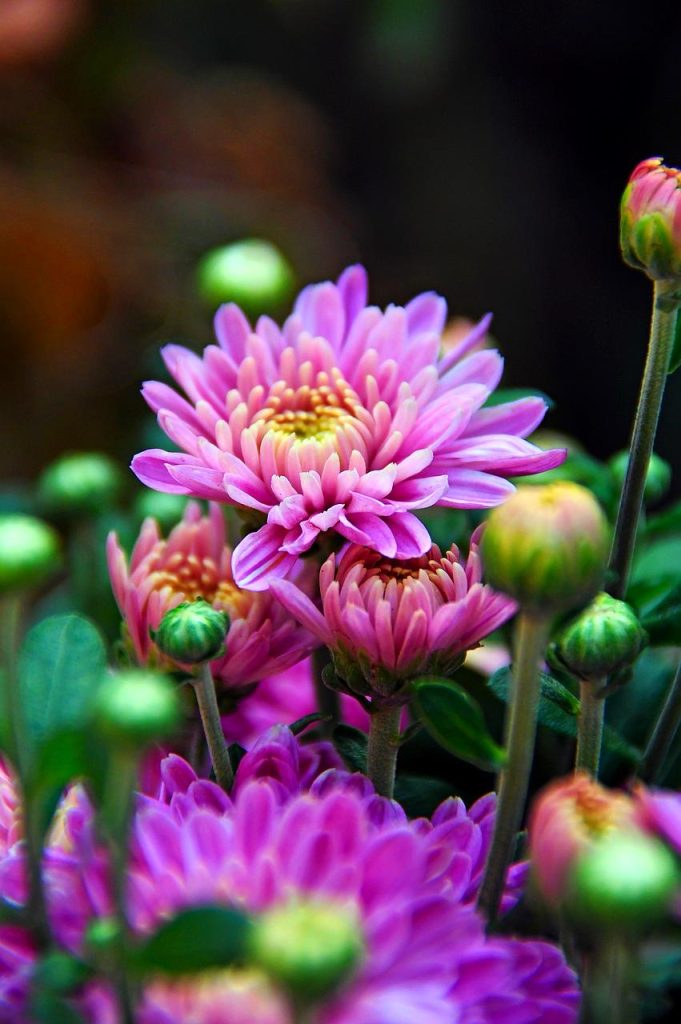
Chrysanthemums, commonly known as Mums, are often celebrated for their dazzling blooms that herald the autumn season. While many varieties thrive in full sun, there are several shade-tolerant cultivars that can enliven the corners of your garden that receive partial shade. Mums bloom in a breathtaking array of colors including deep reds, vibrant oranges, and crisp yellows, making them an excellent way to inject warmth and cheerfulness into shaded spaces as the weather cools.
The fall blooming period of Mums typically spans from late September to early November, coinciding perfectly with the heart of autumn. Their plentiful daisy-like blooms are not only visually stunning but also tend to attract pollinators, contributing to the activity in your garden during this transitional season. Mums thrive best in well-drained soil, and while they prefer full sun, many cultivars are quite resilient and can tolerate some shade, especially in the afternoon heat.
Planting Mums in conjunction with other fall-flowering plants, like Japanese Anemones or Lobelia, can create a gorgeous display of complementary colors, offering a cohesive aesthetic as the leaves change. Additionally, Mums are known for their compact growth habit, making them perfect for border plantings, container gardens, or even as accents amid larger perennials.
Northern Maidenhair Fern
The Northern Maidenhair Fern (Adiantum pedatum) is a gem in the world of shade plants, offering a graceful and delicate structure that adds elegance to fall gardens. Characterized by its fan-shaped leaflets and fine, dark stems, this fern thrives in the shady underworld of woodlands, making it a perfect candidate for shaded areas in your landscape. Its fronds can grow up to 30 inches long, creating a lush carpet of greenery that remains vibrant even as other plants begin to lose their foliage.
In the fall, the Northern Maidenhair Fern continues to hold its charm, showcasing a rich green tone that can shift to shades of yellow and gold as the season progresses. This subtle transformation can provide layers of texture and depth to your garden, especially when juxtaposed with more colorful fall flowers. The delicate nature of the fern’s foliage contrasts beautifully with the sturdier structures of other plants, making it an ideal companion in any garden composition.
Northern Maidenhair loves moist, well-drained soil but requires protection from direct sunlight, thriving best in partial to full shade. Its ethereal quality can be further enhanced by planting it alongside hostas, astilbes, or other ferns, creating an enchanting shady retreat. This fern is also resilient to drought once established, allowing it to thrive in less than ideal conditions without sacrificing its beauty.
Pansies
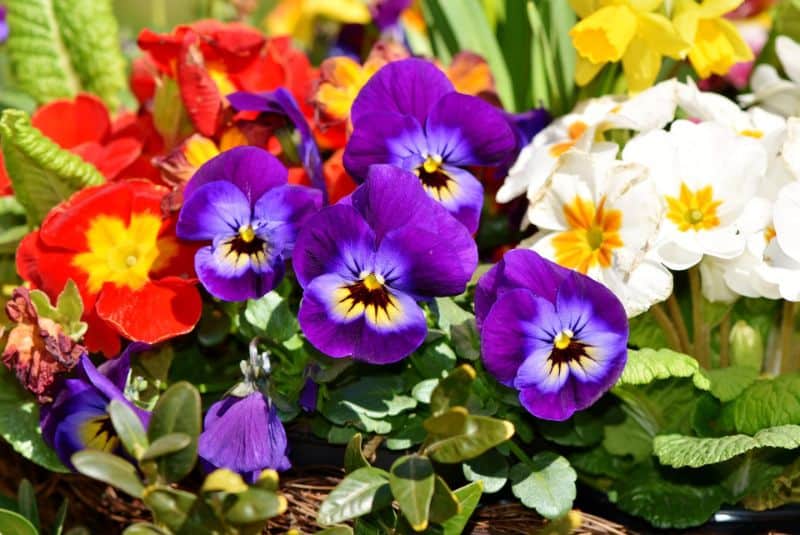
Pansies (Viola tricolor var. hortensis) are versatile and vibrant annuals that can add spectacular bursts of color to shaded areas in the fall. With their wide range of hues—from rich purples and yellows to soft blues and whites—Pansies can invigorate any dim corner of your garden. While often seen as spring favorites, these cheerful blooms can also thrive in the cooler temperatures of fall, providing color when most other plants have started to fade.
Fall-planted Pansies are specially suited for cooler weather, and their blooms can endure frost, making them an ideal choice for early autumn gardens. When planted in rich, well-drained soil, Pansies can bloom profusely, filling shaded areas with vibrant color and attracting beneficial pollinators. Their low-growing habit allows them to perform beautifully in borders, containers, or mass plantings, where clusters of color can create visually striking displays.
One of the unique aspects of Pansies is their ability to adapt to various growing conditions, including partial shade. In fact, in hotter climates, they often prefer some afternoon shade to maintain their vibrant colors. Incorporating Pansies with other fall plants like Mums or ornamental kale can create a dynamic color palette, enhancing the overall garden aesthetic throughout the fall season.
Primrose
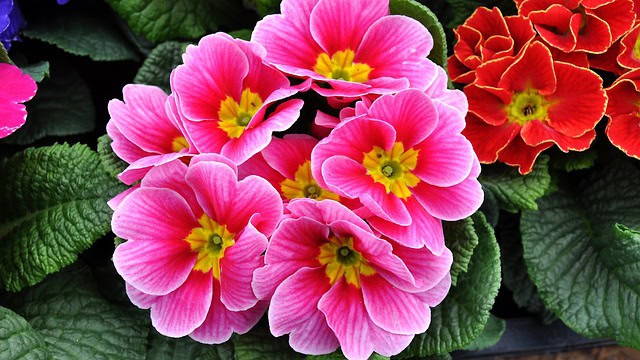
Primrose (Primula) is a group of perennial plants that can add a delightful burst of color to shaded gardens in the fall. Known for their rosettes of leaves and clusters of flowers that bloom in various colors—ranging from sunny yellows and soft pinks to deeper blues—Primroses are not only visually appealing but also versatile in their growing conditions. They thrive in the cooler months, making them a perfect addition to fall gardens.
During the fall, Primrose’s bright flowers can provide a refreshing contrast against the fading foliage of many other plants. Their ability to bloom in partial to full shade ensures that these vibrant florals can gracefully brighten up darker areas of the garden. Primroses also prefer moist, well-drained soil, making them ideal companions in spots where moisture tends to linger.
Another fascinating aspect of Primroses is their ability to naturalize, forming appealing carpets of color over time. This trait can create a delightful visual effect, particularly in a woodland garden. Pairing Primroses with shade-loving plants such as ferns and hostas can amplify the lushness of your garden, making it an inviting and colorful haven throughout the fall season.
Rhododendron
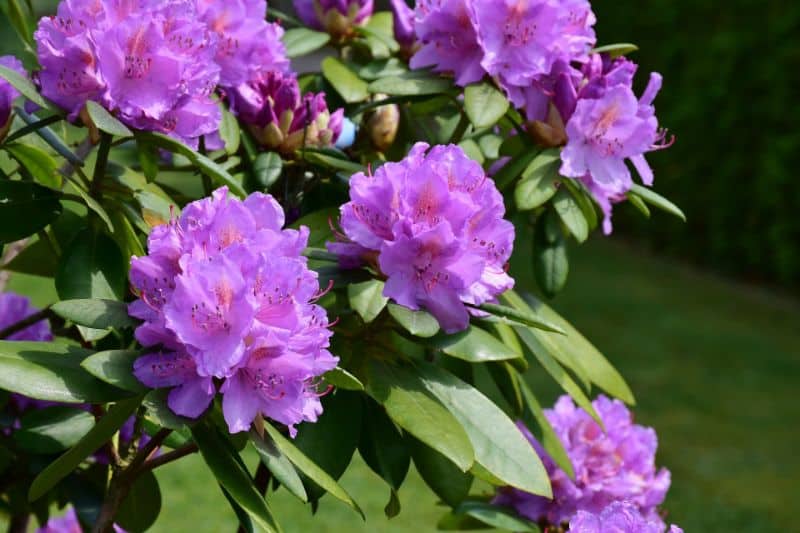
Rhododendron is a widely cherished genus that brings not only enchanting blooms but also impressive foliage to shaded areas in the fall. Known for their large, leathery leaves, these evergreen shrubs provide a lush backdrop throughout the year, while their clusters of trumpet-shaped flowers burst forth in various colors during the late spring and early summer. However, the impact of Rhododendron extends well into the fall, as their foliage often gains rich, earthy tones, creating a stunning display that complements the changing leaves in your garden.
These plants thrive in well-drained, acidic soil and prefer partial shade, making them ideal for the dappled light beneath taller trees or in other shaded locations. Their height can vary from compact varieties that reach about one foot to towering species that can grow up to 15 feet tall, offering gardeners ample design flexibility.
As the fall season progresses, the large leaves of Rhododendron can take on a glossy patina, enhancing the garden’s aesthetic and adding depths of color even as flowers fade. Additionally, establishing a Rhododendron in your garden can provide valuable habitat for birds and other wildlife, fostering a healthy ecosystem. Landscaping with Rhododendron allows you to create a peaceful and serene retreat that continues to impress throughout the cooler months.
Rubella
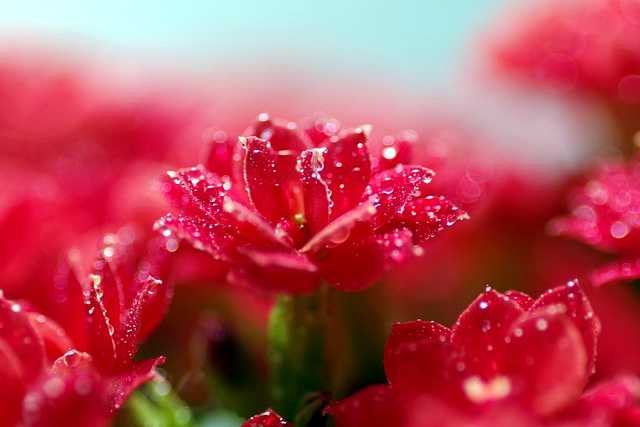
Rubella, commonly known as the Red Twisted Stemmed Willow (Salix purpurea ‘Rubra’), adds a sculptural element and a pop of color to your shaded spaces in fall. This deciduous shrub is notable for its vibrant red stems, which provide striking contrast against the muted greens and browns of the autumn landscape. The twisting nature of its branches creates an intriguing visual effect that enhances the presence of other foliage plants and flowers throughout the season.
This hardy plant thrives in various growing conditions, from full sun to partial shade, and appreciates moist to wet soil, making it an excellent choice for borders or naturalized areas near water features. In fall, the bright red stems of Rubella are particularly eye-catching, offering a seasonal highlight that stands out even in low-light conditions.
Rubella is also suitable for erosion control and can be used effectively to stabilize banks in shaded areas where traditional plants struggle to establish roots. As the colder months approach, consider allowing this plant to complement late-bloomers like Mums or Pansies for optimal contrast and beauty. Over time, Rubella will create a cohesive and textured look in shaded areas, enriching your garden’s overall appeal.
Short’s Aster
Short’s Aster (Symphyotrichum shortii) is a stunning perennial that flourishes in shaded environments and offers a vibrant tapestry of colors during the fall. This native plant is characterized by its rich blue to purple daisy-like flowers that bloom from late summer into autumn, providing a prolific display of color when many other plants are fading away. As the flowers mature, they attract beneficial pollinators, making Short’s Aster a valuable addition to any garden ecosystem.
Growing up to 18 inches tall, Short’s Aster is well-suited for the back of a shady border or as a filler plant in a woodland garden. While it prefers partial shade and thrives in loamy, well-drained soils, it can also tolerate a variety of conditions, adding to its appeal for gardeners seeking resilient options. The bright flowers set against green foliage create a vivid contrast, emphasizing the beauty of shaded spaces.
Additionally, the suitability of Short’s Aster for biomes like woodland and naturalized areas makes it a great choice for creating sustainable gardens. As fall progresses and foliage begins to turn, the delicate blooms of this aster add a lovely finish to the changing landscape, inviting both admiration and ecological diversity into the garden.
Siberian Bugloss
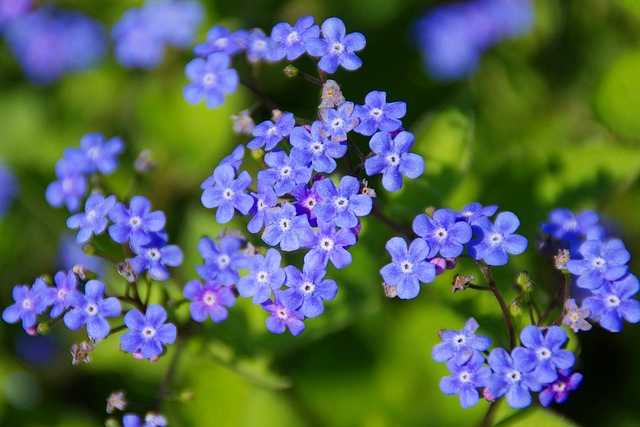
Siberian Bugloss (Brunnera macrophylla), often referred to as False Forget-Me-Not, is a delightful perennial that thrives in shady areas and provides striking foliage and flowers throughout the fall season. Known for its heart-shaped, large leaves, Siberian Bugloss is an excellent ground cover option that can flourish even in challenging conditions. The leaves can appear in vibrant shades of green, sometimes featuring a silvery variegation that adds an elegant touch to the shaded garden.
One of the standout features of Siberian Bugloss is its delicate clusters of small, bright blue flowers that bloom in spring. However, it is the impact of its foliage during the fall that truly captivates. As cooler temperatures arrive, the leaves may begin to take on a yellow or golden hue, creating a warm and inviting contrast against the cooler tones of other plants in the garden. The robust structure of its leaves also provides aesthetic interest, especially when combined with other fall-blooming plants.
Siberian Bugloss thrives in moist, well-drained soil and can adapt to a variety of light conditions, making it an ideal choice for woodland gardens as well as shaded borders. Beyond its visual appeal, this plant is also known for its ability to resist deer and most pests, making it an ideal choice for low-maintenance gardening. This resilient perennial not only enriches the garden’s landscape but also provides a habitat and forage for wildlife, particularly pollinators.
Sweet Alyssum

Sweet Alyssum (Lobularia maritima) is a charming annual that brings a sweet fragrance and delicate blooms to shaded areas in the fall. While most commonly known for its sunny disposition in garden beds and containers during the spring and summer, Sweet Alyssum can continue to deliver fragrant clusters of white, pink, or lavender flowers even as temperatures cool. This adaptable plant makes it a delightful addition to shaded study spots, where its aroma can be appreciated.
Sweet Alyssum thrives in well-drained soil and can grow happily in full sun, partial shade, or even in dappled light. Its low-growing habit makes it perfect for border gardens, hanging baskets, or planting between larger perennials for added texture. In shaded conditions, the plant may stretch slightly as it seeks out light, producing a lighter foliage that pairs beautifully with the play of fall colors in surrounding plants.
One of the most compelling aspects of Sweet Alyssum is its ability to attract pollinators, such as bees and hoverflies, which become a joyful presence in the garden during the fall. The continued blooms contribute not only to visual appeal but also to the health and vitality of your garden ecosystem. Sweet Alyssum is also typically self-seeding, allowing it to return year after year, bringing reliable beauty back to the shaded areas with little effort from the gardener.
Turtlehead
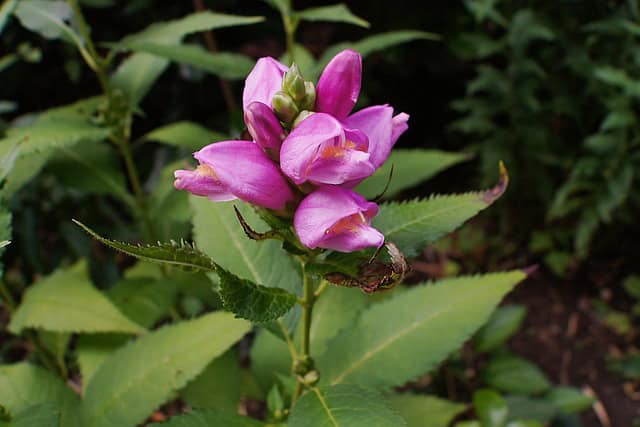
Turtlehead (Chelone glabra) is a native perennial that thrives in moist, shady conditions and presents unique, hooded flowers reminiscent of turtle heads, hence its playful name. Blooming in late summer to early fall, Turtlehead produces clusters of white to pale pink blooms that resemble whimsical turtle heads poking out in curiosity. This stunning plant draws attention in shaded areas and provides a touch of charm that is hard to resist.
Turtlehead prefers rich, moist soils, making it ideal for locations that might experience occasional standing water or for garden plots near ponds or streams. Its ability to flourish in damp environments allows it to outshine many traditional shade plants, offering an attractive, textured addition to your garden. When in bloom, Turtlehead will attract a variety of pollinators, including bees and butterflies, promoting biodiversity and bringing life to your shaded corners as summer gives way to fall.
As the flowers fade, Turtlehead’s bright green foliage provides a lush backdrop that continues to dominate its space, ensuring the plant remains a focal point in the garden even as it prepares for dormancy. When paired with other shade lovers like ferns or Siberian Bugloss, Turtlehead can create a colorful tapestry that showcases the beauty of fall gardens.
Viola

Viola, commonly known as violets, are charming, hardy plants that add delicate beauty and vibrant colors to shaded gardens in the fall. With their heart-shaped leaves and often fragrant, colorful blooms, Violas can enliven any dimly lit area. Available in a variety of species and hybrids, these plants bloom in hues ranging from rich purples and blues to soft yellows and whites, making them versatile for any garden design.
While many garden plants may slow down as temperatures drop, Violas often thrive during the cooler months, making them an ideal selection for fall. Their modest height, typically around 6 to 12 inches, allows them to be used effectively as ground cover or as fillers in between taller perennials. Violas prefer well-drained soil and can grow in varying light conditions, although they flourish in partial shade, making them perfect for under trees or in shady borders.
An exceptional feature of Viola is its ability to self-seed, creating a delightful natural spread in the garden. This means that with minimal effort, you can expect your Violas to return and surprise you with their blooms year after year, providing a continual burst of color even as the seasons change. Additionally, these plants are beloved by pollinators, drawing in butterflies and bees who seek the nectar in their charming blossoms, enhancing the life and vibrancy of your shaded space.
White Wood Aster
White Wood Aster (Eurybia divaricata) is a native perennial that thrives in wooded areas, bringing ethereal white blooms to shaded gardens in the fall. Known for its adaptability to a range of soil types and moisture levels, this plant can flourish in varying conditions, making it an excellent choice for those challenging shady spots. In late summer and into autumn, the White Wood Aster produces small, star-shaped white flowers that create a stunning visual impact against the rich green foliage, often carpeting the ground with delicate blooms.
One of the remarkable aspects of the White Wood Aster is its extended blooming period. As many other plants begin to fade, this aster draws attention with its clusters of light flowers that can linger well into the fall, providing a striking contrast as the leaves of surrounding plants change colors. It attracts a multitude of pollinators, including bees and butterflies, enhancing the ecological value of your garden while helping to promote biodiversity.
The overarching habit of the White Wood Aster contributes to the beauty of a shaded garden, as it can grow up to 3 feet tall. When planted alongside other shade-loving plants like ferns or Violas, it creates a lush tapestry that invites visitors to linger. The combination of textures and colors not only makes for an enchanting display but also fosters a tranquil and inviting environment perfect for enjoying the peacefulness of fall.
Wishbone Flower
Wishbone Flower (Torenia fournieri) is a charming annual that brings airy blooms and a splash of color to shaded gardens during the fall. With its unique tubular flowers shaped like a wishbone, it adds a whimsical touch to flower beds, borders, and containers. Available in various vibrant shades, including blues, purples, and whites, the Wishbone Flower is a fantastic way to manage the transition of light in shady spots, enhancing the visual allure of the landscape.
This plant thrives in moist, well-drained soil and prefers partial shade, making it particularly well-suited for gardens with dappled sunlight. The trailing nature of Wishbone Flower makes it an excellent choice for hanging baskets or to spill over the edges of containers, softening hard lines and adding a sense of whimsy to any garden arrangement. As fall temperatures cool, the flowers continue to bloom, often lasting until the first frost, ensuring a seasonal burst of color that can carry through the cooler months.
The Wishbone Flower is also incredibly low-maintenance and can tolerate varying rainfall conditions once established, making it a perfect option for gardeners who desire an effortless yet beautiful fall display. Pairing Wishbone Flower with other fall shade plants like White Wood Aster and ferns can create an exquisite arrangement of colors and textures, inviting the beauty of the season to your shaded garden.
Woodland Phlox
Woodland Phlox (Phlox divaricata), also known as Wild Phlox or Features of Phlox, is a native perennial adored for its elegant blooms and adaptability to shady environments. This charming plant features fragrant clusters of small flowers that bloom in stunning shades of blue, lavender, and white, creating a visual symphony that gracefully brightens up shaded areas and woodland gardens. Its delicate, star-shaped flowers typically open in spring and can persist into the early fall, offering lasting color even as the temperatures cool.
The height of Woodland Phlox can range from about 12 to 18 inches, making it an excellent choice for woodland borders or naturalized areas beneath deciduous trees. Its vibrant blooms attract a variety of pollinators, including butterflies and bees, contributing to the overall health of your garden ecosystem. As the flowers begin to fade, the plant’s lush, green foliage remains vibrant and can take on charming fall hues, enhancing the visual depth of your shaded landscape.
Woodland Phlox prefers well-drained, rich soil and enjoys moist conditions, making it suitable for areas that may have occasional dampness. Its ability to spread through rhizomes allows it to form lovely colonies over time, creating stunning ground cover that can outcompete weeds while maintaining a natural look. Pairing Woodland Phlox with other fall shade perennials like ferns or hostas can create striking combinations that highlight both texture and color, ensuring that your shaded garden thrives beautifully through the fall months.
Yellow Corydalis
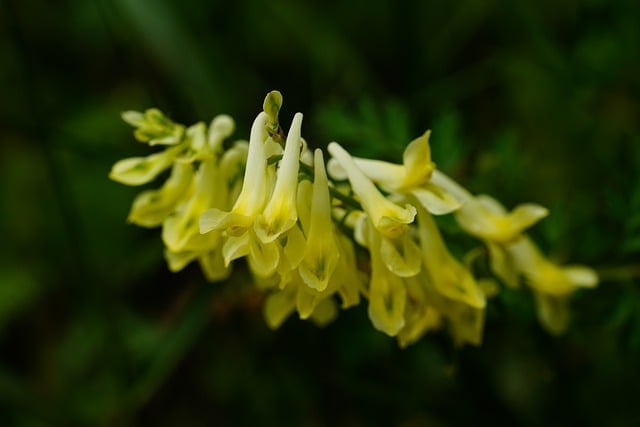
Yellow Corydalis (Corydalis lutea) is a cheerful perennial that adds a burst of sunny color to shaded areas during the fall season. With its small, tubular, bright yellow flowers, this plant can brighten even the shadiest corners of your garden. Blooming from early spring through fall, Yellow Corydalis offers an extended flowering period, injecting warmth and vibrancy into the fall landscape when many other plants begin to fade.
This plant features fern-like foliage that contributes an elegant texture to any garden composition. Yellow Corydalis thrives in partial to full shade and prefers well-drained, humus-rich soils, making it a perfect companion for woodland gardens and shaded borders. Although it’s a perennial, this plant’s self-seeding nature means it can proliferate quickly, creating cheerful patches of yellow that can spread throughout your garden if left unchecked.
One of the key appeals of Yellow Corydalis lies in its adaptability. It is able to tolerate varying soil moisture levels, making it a resilient choice for shade gardens that may have fluctuating water availability. Additionally, the flowers attract a host of pollinators, including bees and hummingbirds, providing much-needed resources in shaded areas where fewer plants may bloom. Combining Yellow Corydalis with other shade-loving plants, such as Woodland Phlox or other colorful fall perennials, can yield delightful arrangements that showcase the joy of fall gardening.
Incorporating Woodland Phlox and Yellow Corydalis into your selection of fall plants for shade can create a dynamic and engaging garden full of life and color. These plants exemplify the beauty that thrives in less-than-full sun conditions, allowing you to maximize the potential of shaded areas while celebrating the colorful transitions of the fall season. By introducing these distinctive species, you can create a captivating and inviting retreat in your garden that remains enchanting throughout the autumn months and beyond.


